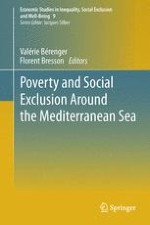2013 | OriginalPaper | Buchkapitel
2. Building a Material Deprivation Index in a Multinational Context: Lessons from the EU Experience
verfasst von : Alessio Fusco, Anne-Catherine Guio, Eric Marlier
Erschienen in: Poverty and Social Exclusion around the Mediterranean Sea
Verlag: Springer US
Aktivieren Sie unsere intelligente Suche, um passende Fachinhalte oder Patente zu finden.
Wählen Sie Textabschnitte aus um mit Künstlicher Intelligenz passenden Patente zu finden. powered by
Markieren Sie Textabschnitte, um KI-gestützt weitere passende Inhalte zu finden. powered by
